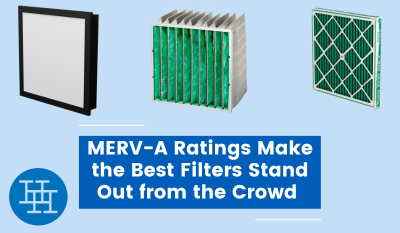MERV-A Ratings Make the Best Filters Stand Out from the Crowd

Wintertime is the season of sickness. The flu, COVID-19, common colds, RSV, and all sorts of unnamed viral infections seem to run rampant as the cold weather keeps us inside huddling for warmth. Times like these make us extra thoughtful about the cleanliness of our indoor air.
Air filters are a key defense in maintaining Indoor Air Quality (IAQ) by managing the spread of germs and reducing pollutants that can irritate our airways and worsen respiratory symptoms.
The efficacy of any given air filter is shown by its MERV rating (minimum efficiency reporting value) - a standard set by ASHRAE to indicate the filter’s effectiveness at trapping particles between 0.3 to 10 microns in size.
Understanding MERV ratings and what kind of filtration is necessary to uphold your building’s IAQ can help you make informed choices to elevate your building's air quality and the well-being of occupants.
The MERV scale ranges from 1 to 16, indicating the filter's ability to capture particles. The higher a filter’s MERV rating, the better it is at capturing smaller particles.
However, a filter’s capabilities can change with use – that's why we change them as frequently as recommended by the manufacturer – and MERV ratings only tell us a filter’s efficiency at the time of installation. Our friends at Camfil explained it well:
“Air filters can be produced with an electrostatic charge which acts much like a magnet and temporarily increases the particle capture efficiency on the three size ranges,” they wrote in a 2020 blog. “This results in a higher MERV value assigned to the filter. However, as the filter begins to load with dirt, the charge can no longer attract particles and the MERV value drops.”
“A MERV-13 filter, for example, can drop to a particle capture efficiency equivalent to that of a MERV-8 filter within a short period of time, leaving people and equipment less protected than had the filter remained as a MERV-13.”
This is where MERV-A ratings become helpful. MERV-A ratings are determined through a method that tests filters without electrostatic charge. This rating denotes the actual efficiency level your filter will operate at during its life. Filters will still need to be changed as recommended by the manufacturer for optimal efficiency.
Camfil’s 30/30® Dual 9 filter boasts a MERV 9A rating and is guaranteed to last 9-12 months. This filter underwent three years of real-life testing to ensure performance in various buildings. Its strong build is designed to withstand harsh airflow and the radial pleat design exposes all the filter media to the airstream, leading to lower pressure drop and higher dirt holding capacity.
Heavier duty filters come by way of Camfil’s bag filters like City-Flo and Hi-Flo, with MERV ratings from 11/11A to 14/14A, or Compact Filters like Durafil and Opti-Pac, with ratings ranging from MERV 11/11A to 16/16A.
Determining the right Camfil filter for your Air Handling Unit will depend on the specs of the unit and the IAQ needs of your building. A Hoffman & Hoffman sales representative can provide life cycle costs and develop optimal filter changes to minimize the total cost of operating your new filters. To find the right solution for your commercial building, inquire with us today!
// about the author
.png)
 Ally O'Reilly
Ally O'Reilly
Ally O'Reilly is a Marketing Coordinator for the Hoffman Family of Companies. She enjoys learning about the ways the HVAC industry is growing and changing!












